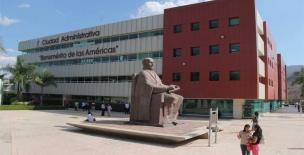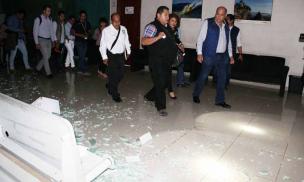Chris Gatto, PhD Candidate, History
On Thursday, September 7, 2017, a magnitude 8.1 earthquake struck off the Pacific coast of Mexico, killing over 100 individuals and damaging thousands of homes in the southern states of Chiapas, Oaxaca, and Tobasco.1 This was the strongest earthquake the country had experienced since 1787. While earthquakes are a fairly common occurrence in Mexico, this particular event caused more alarm and destruction than could have ever been anticipated.
The earthquake struck at approximately 11:30 pm, and I acutely remember standing in the bathroom of my Airbnb in Oaxaca City, brushing my teeth and getting ready to go to bed. I was concluding nearly two months of archival research in Oaxaca for my dissertation, entitled “From Cochineal to Coffee: The Making of a New Rural Society in Miahuatlán, Oaxaca, 1780–1880.” The door to my small apartment began to shake violently, and my initial thought was that someone was trying to break in. As I walked over to see what was happening, I immediately fell to the ground, as the floor beneath me began to shake. The power in the city then went out, and in complete darkness it became all too clear to me and everyone else in the city what was occurring.
While my first thought was to text my anxious mother (before she uncovered the news of the earthquake on her own), I then began to consider how this would affect the work I still needed to get done. I was finishing nearly six weeks of research in the Archivo Histórico de Notarías, a vast archive inside the Church of Santo Domingo right in the heart of Oaxaca City. This archive is home to nearly 2,000 volumes of notarial documents from the early 17th century all the way up until the 20th century, including land purchases and rentals, wills, contracts, and inventories. Needless to say, this archive plays an essential role in my dissertation, which explores the dramatic agricultural transformation that occurred in the southern part of the state from cochineal to coffee cultivation over the course of the 19th century.
The Archivo Histórico de Notarías is now fully digitalized, but researchers still need to spend considerable amounts of time with the original documents, identifying book and page numbers before proceeding to the Dirección General de Notarías, an office located in the Ciudad Administrativa about 15 minutes outside of the city, to begin a complicated process (trámite) of requesting digital copies. While I knew the Archivo itself would be closed for several days (as it was, although thankfully with limited damage), I was also concerned about the Ciudad Administrativa, where I needed to travel with a flash drive to collect all the images I had been identifying over the past month.
- The main square of the Ciudad Administrativa on an average day
- Ciudad Administrativa after the earthquake
- Ciudad Administrativa after the earthquake
The first image above depicts the main square of the Ciudad Administrativa on an average day, while the next two images reflect the damage suffered following the earthquake. Suffice it to say, these offices would not reopen for quite some time, as government workers refused to return to the campus until proper working conditions had been restored. I remember visiting the Ciudad Administrativa during that week, hoping I could find someone, anyone, that could help me gain access to the hard drive and expedite the transfer of images. However, I was promptly turned away, as they insisted I would have to return the following week. Unfortunately, I did not have another week, and I flew back to Chicago on September 16 with the sick feeling that so much time and effort had been expended for nothing. While I was determined to return to Oaxaca soon to complete my research, I knew there were further challenges I would eventually have to overcome…
- Protests at the Ciudad Administrativa
- Protests at the Ciudad Administrativa
The Ciudad Administrativa, along with the Ciudad Judicial, are the two largest government offices in Oaxaca. However, on any given day, access to these offices is severely restricted, since they become the site for a range of protests from different social organizations and unions across the region, including taxi drivers (taxistas), teachers’ unions (maestros), and indigenous rights activists. These groups block access to the Ciudad Administrativa in different and often inventive ways (as shown in the images above), and when this happens, nobody can enter or leave the campus until the groups disassemble. These protests have become so routine that the public has become accustomed to the disruptions and adjust their schedules accordingly. Whatever one thinks of the validity of these protests (I happen to be quite sympathetic), they cause significant disturbances in the life of ordinary residents in the city, and you will often hear people expressing sympathy for the causes but not necessarily the tactics.
In organizing my trip back to Oaxaca, I knew I would have to allow several days for a procedure that should only take a couple hours. On the week of October 23, 2017, I flew back to Oaxaca, allowing five days (Monday through Friday) to get my work completed. I anxiously checked my Twitter feed on an hourly basis to identify reports of potential blockades (bloqueos) at the government campus. As it turns out, I was able find a small window early Tuesday morning to enter the Ciudad Administrativa and complete the process of acquiring nearly 1,000 images that will hopefully form an important part of my dissertation. Shortly after I entered, the campus was closed off, and we could not leave until 6pm that evening. The campus experienced similar protests on Wednesday, Thursday, and Friday of that week, and thus I was incredibly fortunate to find the small window that I did to get my work completed.
Researchers in Mexico and across Latin America face these types of logistical challenges on a regular basis, and I do not mean to suggest that what I have faced is unique or atypical in any way. But my work in Oaxaca does show how precarious the work of historians can be, given that we are forced to rely on documents that readily become available or unavailable according to shifting circumstances beyond our control. I hope my dissertation can make good use of the materials I have been lucky enough to uncover, and shed light on historical processes that help us better understand such a dynamic and important region of Mexico.
- This should not be confused with the second earthquake that occurred near Mexico City on September 19, 2017, with a magnitude 7.1 that killed nearly 400. ↩






